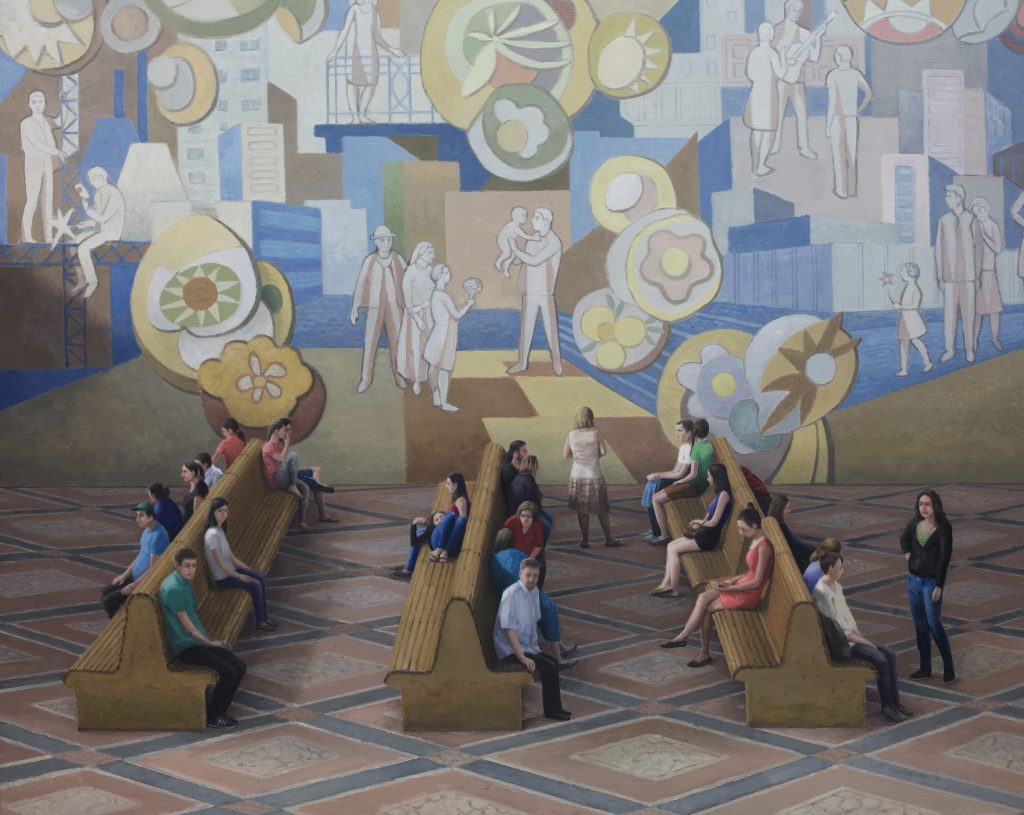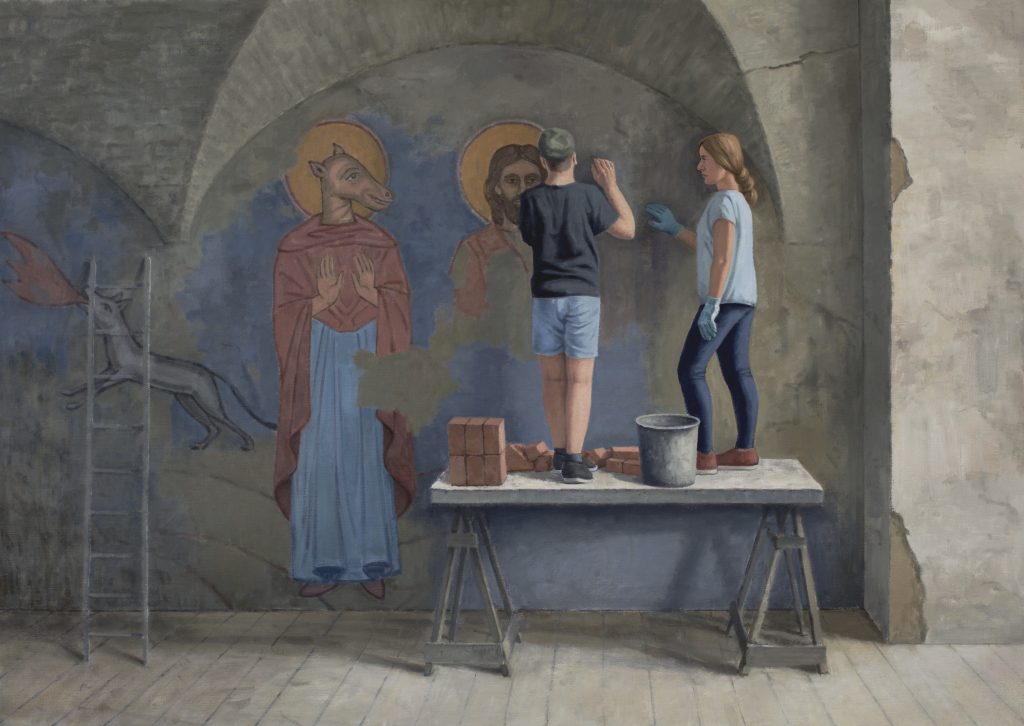:quality(80)/business-review.eu/wp-content/uploads/2024/04/Serban-Savu.png)
Until November 24, 2024, Romania will showcase an exhibition into the intricate dynamics between work and leisure at the prestigious Venice Art Biennale, featuring the works of Serban Savu. Curated by Ciprian Muresan and spanning across the national Pavilion at Giardini della Biennale and the New Gallery of the Romanian Institute of Culture and Humanistic Research in Venice, this exhibition promises to offer a profound exploration of the complex relationship between labour, leisure, and societal norms. Business Review had the opportunity to engage with the Romanian team entrusted with representing the country for La Biennale.
How has your enduring friendship and artistic partnership with Ciprian Mureșan shaped not only your individual artistic trajectory but also the conceptualization and realization of projects such as the one presented at the Venice Biennale?
Although Ciprian and I are very different in essence, the friendship that binds us and the fact that we share a studio for so many years has certainly contributed to my artistic development. I am mostly inspired by his conceptual approach and the versatility with which he works in various artistic mediums, from photography to drawing, from sculpture to engraving or video.
Our collaboration for the project at the Venice Biennale came very naturally, in our daily discussions. Ciprian identified a recurring theme in my work over the past twenty years and proposed to build the project for the Venice exhibition around the relationship between work and leisure. Also, after the exhibition we had in 2021 at the National Museum of Contemporary Art in Bucharest, where I presented an architectural model with a mosaic embedded in its heel, Ciprian proposed to amplify this direction to create a dialogue between painting and these hybrid objects.
From your perspective as an artist interested in the layers of history and mechanisms of cultural memory, how does your previous experience influence your approach to participating in exhibitions, particularly under Ciprian Mureșan’s curatorship?
The theme we address in the project “What Work Is” does not exclude other important themes from my work, such as the history and memory of culture. In the context of the Venice exhibition, they remain adjacent themes, subordinate to the central theme of work and leisure, but still present and very visible otherwise. However, a curatorial discourse and an exhibition within an event of such magnitude and diversity cannot dissipate and fragment around multiple themes, but must coherently respond to a current issue intensely debated today, such as the theme of the relationship between work and leisure.

In what ways does your connection to Venice, both as a city of soul and professional growth, influence the selection and creation of artworks within the exhibition, particularly considering the theme and context of the Biennale?
For me, Venice means the art of the great masters of the Venetian school such as Bellini, Giorgione, Titian, Tintoretto, Veronese, Tiepolo, or Guardi, whom I have had the chance to study thoroughly, but also the experience of the art biennale whose editions I have visited since 2003. This cultural background could not leave me indifferent, and for the project at the Romanian Pavilion, I prepared an immense polyptych, a canonical form of religious art abundant in Venice. In this polyptych, dedicated to work and leisure, we will introduce forty-five paintings that sum up my artistic practice over the past fifteen years. Also, at the New Gallery of the Institute of Culture and Humanities Research, we will create during the seven months of the exhibition a monumental mosaic with a picnic scene, a May 1st celebrated today by ordinary people living in former working-class neighborhoods. This large-scale mosaic echoes one of the mosaics inserted in the models presented in the Pavilion, namely the work “True Nature,” 2021. Why mosaic? Precisely because of the importance that mosaic technique has in Venetian art throughout history, such as the wonderful examples from the Santa Maria Assunta church in Torcello and, of course, the superb mosaics from the San Marco church. What we propose is a dialogue with Venetian art, but coming from a completely different historical and cultural context. The mosaic we want to produce reiterates the theme of celebrating May 1st, which appears in official propaganda art from the socialist realism period, but is freed from ideology, without the pathos typical of public works from that period. It is a mundane scene of a barbecue outing, which, at the end of the Biennale, we intend to donate to a public space in the city of Chișinău, a city whose public works from the socialist realist period have inspired me a lot in recent years.
Your project “WHAT WORK IS/CE ESTE MUNCA” delves into the complex iconography of labor and leisure, drawing inspiration from historical realism, its ideologies, and propaganda from the Eastern Bloc. How did you navigate the balance between honoring these historical contexts and infusing your own artistic interpretation into the exhibition?
I look at today’s world through the filter of art history, and the themes used in socialist realist art represent my starting point. The theme of labor, of the worker, agricultural or industrial themes, I transposed them to the present day. I don’t talk about the past except by paraphrasing it and using art history to look at the world today, trying to observe what has happened to us since ’89. I am interested in a view of the image that is non-ideological, outside of propaganda, outside the ideological space. I have created paintings with non-heroic characters: ordinary people who are somewhat adrift, caught between two worlds, between two systems.
The theme of this year’s Venice Biennale, “Foreigners Everywhere,” seems to resonate deeply with your work, particularly in exploring themes of disorientation and longing for home associated with labor migration. Could you elaborate on how these themes manifest in your paintings and contribute to the broader narrative of the exhibition?
As you know, the Venice Art Biennale has two major sections: the curated exhibition and the section dedicated to national pavilions. This year, the curator of the central exhibition is Adriano Pedrosa from São Paulo, who proposed the title and theme of the exhibition “Foreigners Everywhere.” Typically, national pavilions do not respond to the theme of the curated exhibition, nor could they, because the details of the exhibition are announced quite late, and there is no way to prepare an exhibition in the national pavilion in such a short period. When Ciprian and I thought about applying for the national selection competition, the theme of the Biennale had not yet been announced. However, the theme proposed by us is a vast one and intersects with the general theme of the Biennale in a fortunate way. Labor includes alienation through migration, even though this is not explicitly present in my paintings. Instead, the characters populating my works are alienated by the change in the socio-economic-political system, carried by the current, by the current of history.
Your paintings within the Romanian Pavilion depict disoriented protagonists and awkward figures suspended between work and recreation. What inspired this portrayal, and what do you hope viewers take away from experiencing these artworks in person?
I am inspired by characters who are between worlds, hybrid characters who are not assimilated into either the rural or urban, people who work during leisure time or who rest during working hours, people suspended in an anarchic space, outside the productive system, trying to find their freedom and meaning. The only expectation I have from the audience is to find new meanings in my works, interpretations that I have not thought of before.

How do you envision the integration of the polyptych featuring 40 paintings spanning the last 17 years of your career alongside the architectural models and other installations shaping the narrative of your exhibition in Venice?
I created my first polyptych in 2014, and it was called “The Polyptych of Labor and Leisure.” In 2015, I introduced in the background of a painting the image of a socialist realist mosaic. These are themes and ideas that have concerned me for a long time, and it is natural for things to connect for an exhibition like the one we are preparing in Venice. The architectural models containing mosaics appeared because I had some ideas that I couldn’t express just in painting, but also for practical reasons: in 2010, together with Raluca Voinea, curator and art critic, we were looking for a public space in Bucharest to create a large-scale mosaic, but for financial reasons, this project did not materialize. However, the idea remained, and to give it shape, I used the architectural model as a means of artistic expression. In the exhibition in Venice, we use themes, ideas, and expressions that are part of a unified vision, even though we present seemingly non-synonymous forms.
In what ways do you anticipate the interventions by the graphic design artists from Atelier Brenda, Nana Esi, and Sophie Keij, utilizing the facade and entrance of the Romanian Pavilion, to enhance the viewer’s understanding of the exhibition’s message and facilitate public engagement?
Ciprian’s idea to invite the graphic design studio Atelier Brenda from Brussels comes from his very versatile artistic practice, in which he experiments with various mediums to express his thoughts. Making an analogy, I see this collaboration as a cover for the content of a book. The language of graphic design, that of street advertising, has an immediate impact, communicates directly with the public, and the ideas contained in the pavilion can be expressed in this direct way. The monumental facade will unequivocally convey the theme of our exhibition, and yet it will not be devoid of subtlety, it will respond aesthetically to the works exhibited inside the pavilion.
How do you envision the interactive experience for visitors as they navigate through the exhibition space, encountering the various elements, including the polyptych, architectural models, and graphic interventions, all contributing to the exploration of the theme “WHAT WORK IS/CE ESTE MUNCA”?
The theme of work and leisure is a universal theme, even though the expressions inside the pavilion belong to a specific cultural and geographical space. The public is called to the pavilion by the monumental message on the facade, encountering in the pavilion’s lobby an installation by Atelier Brenda that can be seen as a key to interpreting the works in the exhibition, and then, inside the pavilion, they will have the experience of being in front of a truly impressive polyptych (over 20 meters long and 5 meters high). We have all experienced the exhausting experience of visiting the Biennale on a typical Venetian day, hot and humid, therefore we imagine the pavilion space as one of reflection and meditation, the tired visitor being able to sit on the pedestal-benches and contemplate quietly the polyptych, but at the same time to look at the architectural models immediately nearby, in this game of macro- and micro-perspectives.



:quality(80)/business-review.eu/wp-content/uploads/2024/03/Romanian-art-galleries.png)




:quality(80)/business-review.eu/wp-content/uploads/2024/02/IMG_6951.jpg)

:quality(80)/business-review.eu/wp-content/uploads/2024/04/COVER-1.jpg)



:quality(50)/business-review.eu/wp-content/uploads/2024/01/alexandru-ionescu-IZp_WA5FTbY-unsplash.jpg)
:quality(80)/business-review.eu/wp-content/uploads/2024/04/cover-april.jpg)
:quality(50)/business-review.eu/wp-content/uploads/2023/10/sorina-faier-2023-wide.jpg)
:quality(50)/business-review.eu/wp-content/uploads/2024/04/BeFunky-collage-49-scaled.jpg)
:quality(50)/business-review.eu/wp-content/uploads/2024/04/Legion-Tab-Lifestyle-scaled.jpg)